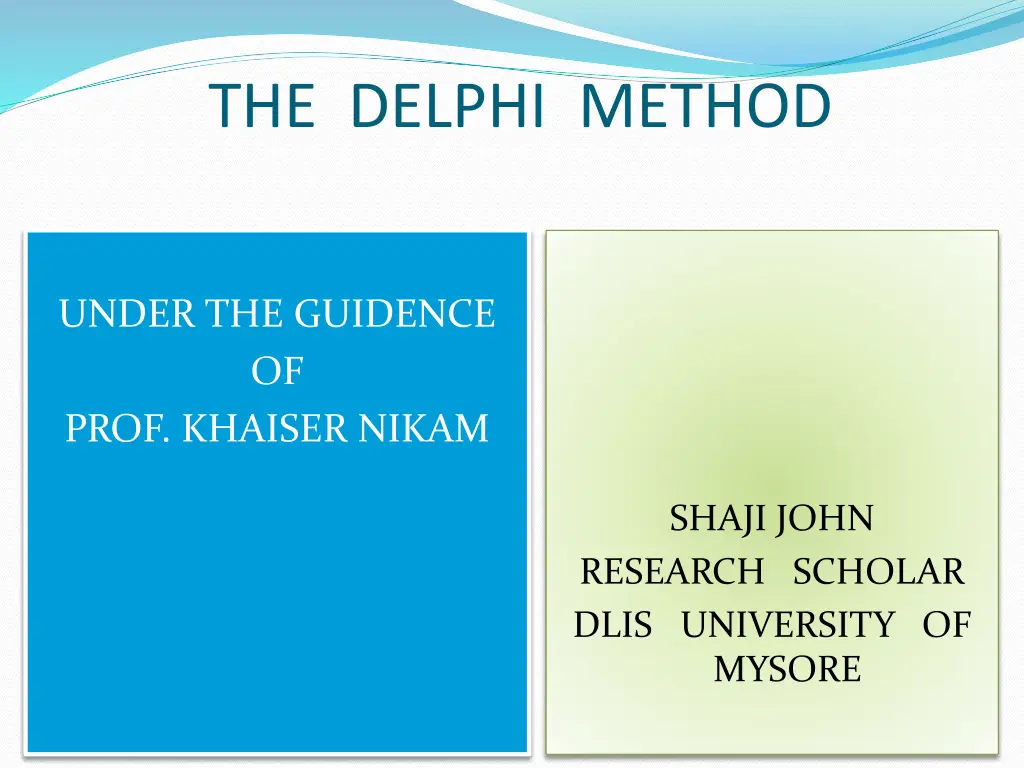
Understanding the Delphi Method in Group Decision Making
Explore the Delphi Method, a group decision-making technique developed in the 1950s, which aims to reach consensus through anonymous questionnaires sent to experts. Learn about its origin, process, and historical significance from ancient Greece to modern research applications.
Download Presentation

Please find below an Image/Link to download the presentation.
The content on the website is provided AS IS for your information and personal use only. It may not be sold, licensed, or shared on other websites without obtaining consent from the author. If you encounter any issues during the download, it is possible that the publisher has removed the file from their server.
You are allowed to download the files provided on this website for personal or commercial use, subject to the condition that they are used lawfully. All files are the property of their respective owners.
The content on the website is provided AS IS for your information and personal use only. It may not be sold, licensed, or shared on other websites without obtaining consent from the author.
E N D
Presentation Transcript
THE DELPHI METHOD UNDER THE GUIDENCE OF PROF. KHAISER NIKAM SHAJI JOHN RESEARCH SCHOLAR DLIS UNIVERSITY OF MYSORE
THE DELPHI METHOD INTRODUCTION The Delphi Method is a group decision making technique developed by Olaf Helmer and Norman Dalkey of the Rand Corporation as part of an Air Force sponsored Rand Corporation study in the early 1950's., for the purpose of addressing a specific military problem. The Delphi Method seeks to achieve a consensus among group members through a series of questionnaires. The series of questionnaires sent either by mail or via computerized systems, to experts. Nobody looses face because the questionnaires are answered anonymously and individually by each member of the group. The answers are summarized and sent back to the group members along with the next questionnaire. a pre-selected group of
This process is repeated until a group consensus is reached. This usually only takes two iterations, but can sometimes takes as many as six rounds before a consensus is reached
ABOUT THE ORIGIN OF NAME The Delphi Method takes its name from the legend of the Oracle at Delphi in ancient Greece. According to the wishing to gain a glimpse into the future would gather in a special chamber deep dedicated to the God Apollo located in the coastal town of Delphi. The crowd would listen to the Pythia, a woman, obviously in an entranced state, perched on a three- legged stool, prophetic messages from the deity through the temple s priests. priests translated otherwise unintelligible utterances. Thus, the ancient priests were the experts in interpreting the Pythia s messages about the future. DELPHI ARCHAEOLOGICAL SITE legend, those within a temple who channeled The the Pythia s
DELPHI - DEFINITIONS According to Delbecq, Van de Ven, and Gustafson(1975) The Delphi method is method for the systematic solicitation and collection of judgments on a particular topic through a set of carefully designed sequential questionnaire interspersed information and feedback of opinions derived from earlier response with summarized The communication dispersed experts (Adlerand Ziglio, 1996). Delphi method among is a an panel exercise of in group geographically
Wechsler characterizes a 'Standard-Delphi-Method' in the following way: 'It is a survey which is steered by a monitor group, comprises several rounds of a group of experts, who are anonymous among each other and for whose subjective-intuitive prognoses a consensus is aimed at. After each survey round, a standard feedback about the statistical group judgments calculated from median and quartiles of single prognoses is given and if possible, the arguments and counterarguments of the extremeanswersare fed back...' (Wechsler 1978).
Delphi method is most suitable The Delphi method is especially useful for futuristic Projects (long-range forecasting 20-30 years), as expert opinions are the only source of information available. Top secret and complex military projects When time & cost constraints make frequent face- to-face meetings difficult to arrange. When the heterogeneity of the participants must be preserved and anonymity assured. In situations where there is no clear-cut resolution of a given policy issue
DELPHI PROCEDURE Fowles(1978) describes ten steps for the Delphi method 1 Formation of a Delphi team to undertake a Delphi on a subject. 2 Selection of expert panel(s). 3 Development of the first round questionnaire 4 Testing the questionnaire for proper wording.
5 Transmission to the panelists. 6 Analysis of 1st responses 7 Preparation of 2nd round. 8 Transmission of 2nd round questionnaires to the panelists 9 Analysis of the 2nd round responses (7 to 9 may be repeated to get consensus) 10 Preparation and presentation of report
Delphi Positive Anonymity participants makecontributionsof ideas a safeactivity Conducted in writing and does not require face-to-face meetings responses can be made at the convenience of the participant Opportunities for large number of experts to participate Opportunities for participants to reconsider their opinions Gives access to groups of widely dispersed experts can be guaranteed, anonymity for Continued
Time forreflection, improving the strength of opinion. Participants have an equal say Greater acceptance of Delphi results than other consensus methods. Learning and motivating experience forparticipants. Highly cost-effective, when conducted byexperts Relatively free of social influence, and individual dominance and is, therefore, conducive to independent thinking and gradual formulation of reliable judgments or forecasting of results pressure, personality
DELPHI NEGATIVS Large amountof time toconductseveral rounds The complexityof dataanalysis The difficulty of maintaining participant enthusiasm throughoutprocess Potential of Low Response Rates Due to the multiple feedback processes The power of persuasion or prestigious individuals to shape group opinion The vulnerability of group dynamics to manipulation Continued
Manipulation, the responses can be altered by the monitors in the hope of moving the next round responses in a desired direction. Care needed in this regard The bandwagon effect of a majority opinion Ambiguity regarding panel size and consensus levels required
